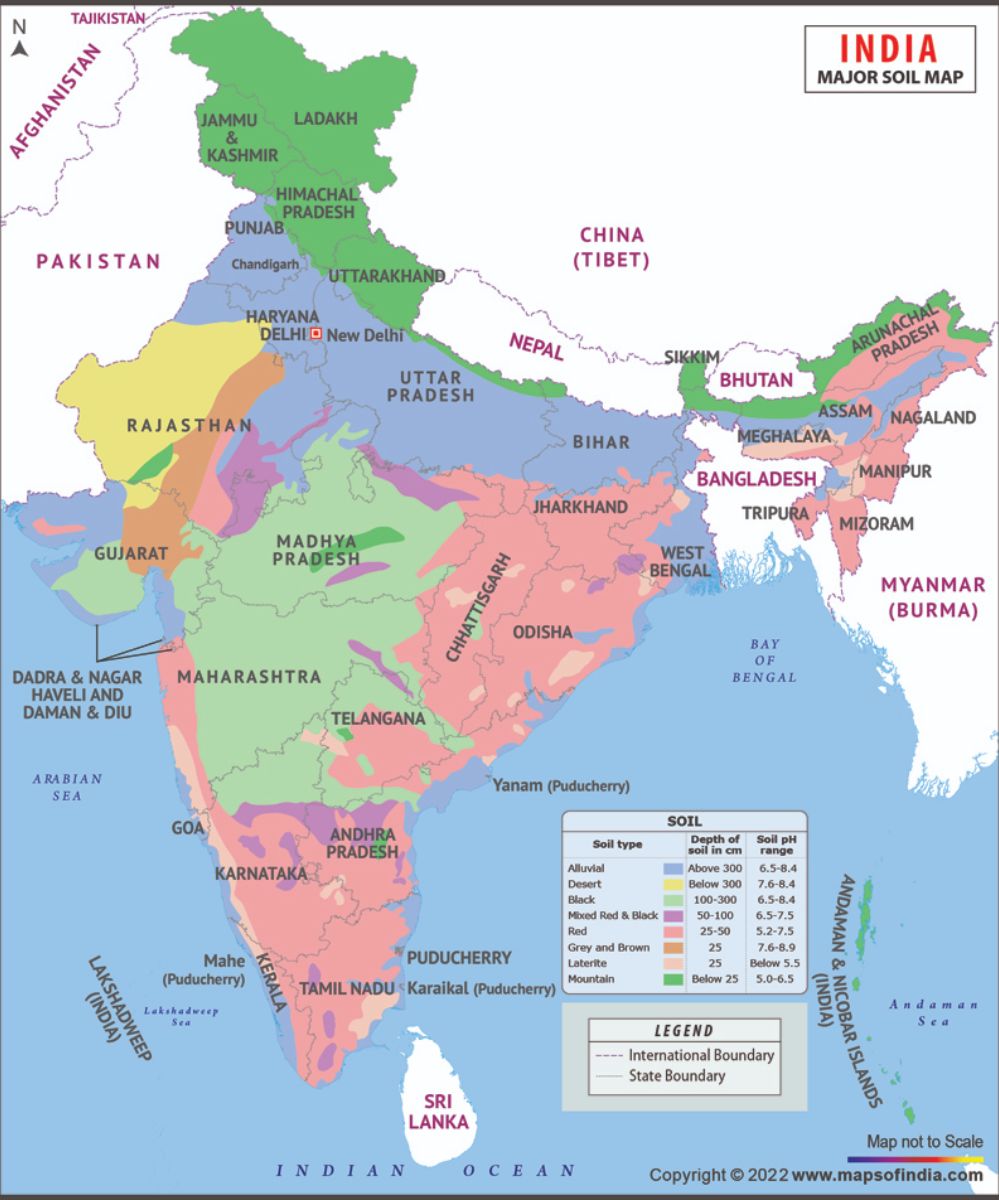Key Points
- India has diverse soils shaped by climate, rocks, and geography, each supporting different crops.
- The five main soils are Alluvial, Black, Red & Yellow, Laterite, and Arid (Desert) soil, while Forest, Saline, and Peaty soils occur regionally.
- This variety of soils makes India’s agriculture rich and versatile, from cotton in black soil to rice in alluvial plains.
Types of Soil: India is often referred to as an agricultural country, and rightly so. With nearly 60% of its population engaged in farming, the type of soil found in different regions plays a big role in shaping the crops grown there. If you look around, you will notice that some areas are famous for rice, others for cotton, and still others for wheat or pulses.
Have you ever wondered why this differentiation? The secret to this lies under our feet, the soil. India is a vast landscape that is blessed with different types of soil, each carrying its own unique features, fertility, and capacity to support certain crops.
Knowing about these soils is not just important for farmers, but also for students preparing for competitive exams and anyone curious about how nature supports life.
Types of Soil in India
Overall, the soils can be diversified into various types, but for now, let’s explore some major types of soil found in India.
Check out: List of Top 9 Largest Impact Craters on Earth: Ranked
| Sr. No. | Type of Soil | Major Regions | Crops Suited |
| 1 | Alluvial Soil | Northern Plains (Indo-Gangetic-Brahmaputra plain), River Valleys, and Coastal Plains. | Rice, Wheat, Sugarcane, Maize, Pulses, Oilseeds. |
| 2 | Black Soil | Deccan Trap region (Maharashtra, Malwa Plateau, parts of Gujarat, Andhra Pradesh, Karnataka). | Cotton, Sugarcane, Jowar, Tobacco, Oilseeds. |
| 3 | Red and Yellow Soil | Eastern and Southern parts of the Deccan Plateau (Odisha, Chhattisgarh, parts of Tamil Nadu, Karnataka, and Telangana). | Millets, Groundnut, Pulses, Oilseeds. |
| 4 | Laterite Soil | Areas of high temperature and high rainfall (Western Ghats, Eastern Ghats, parts of Assam, Odisha, and Kerala). | Tea, Coffee, Cashew, Rubber, Coconut. |
| 5 | Arid Soil (Desert Soil) | Western Rajasthan, North Gujarat, and South Punjab. | Bajra, Jowar, Guar, Pulses (drought-resistant crops). |
| 6 | Forest and Mountain Soil | Hilly and mountainous regions with sufficient forest cover (Himalayan regions, Western and Eastern Ghats). | Tea, Coffee, Spices, Temperate fruits (Apple, Pear), Rice (on terraced slopes). |
| 7 | Saline and Alkaline Soil | Arid and semi-arid regions, waterlogged and swampy areas, and coastal deltas (parts of Punjab, Haryana, UP, and Gujarat). | Salt-resistant crops like Barley, Gram, Cotton, and Dhaincha (for reclamation). |
| 8 | Peaty and Marshy Soil | Areas of heavy rainfall and high humidity with poor drainage (Coastal Kerala, parts of West Bengal's Sundarbans, Odisha). | Rice, Jute, Spices (in suitable areas). |

Source: mapofindia.com
1. Alluvial Soil
Alluvial soil is the most fertile and widely spread soil in India. Found mainly in the Indo-Gangetic plains, it is rich in potash and lime but poor in nitrogen. Textures of this soil may vary from sandy to silty loam. The soil is divided into old alluvium (Bhangar) and new alluvium (Khadar).
2. Black Soil
Also called ‘Regur soil’ or ‘black cotton soil,' this type is found in Maharashtra, Madhya Pradesh, Gujarat, and parts of Tamil Nadu. It is characteristically formed from the weathering of volcanic rocks (lava flows) and is typically clayey, deep, and impermeable. A key feature of this soil is its exceptional moisture retention capacity. Chemically, it is rich in minerals such as iron, lime, magnesia, and alumina, but is notably poor in phosphorus, nitrogen, and organic matter.
3. Red Soil
Red soil gets its colour from iron content. Found in the southern and eastern parts of India, it is less fertile but suitable for crops like groundnut, pulses, and millets with proper irrigation. Structurally, it is quite porous and friable.
4. Laterite Soil
Laterite soil is rich in iron and aluminum but poor in organic matter. It is found in Karnataka, Kerala, and Odisha. With good fertilization, it supports tea, coffee, and cashew crops. A unique characteristic is its physical state: it becomes soft when wet but hardens like a brick upon drying, making it suitable for use as a building material.
Check out:List of Largest Man-Made Lakes In The World
5. Arid Soil (Desert Soil)
As the name suggests, this soil dominates Rajasthan and parts of Gujarat. Sandy and low in moisture, it supports crops like bajra, jowar, and barley when irrigated properly. A notable feature is the presence of hard layers of calcium carbonate concretions (Kankar) in the lower horizons, which effectively restrict the infiltration and circulation of water.
Enter your Blink text here...
Comments
All Comments (0)
Join the conversation